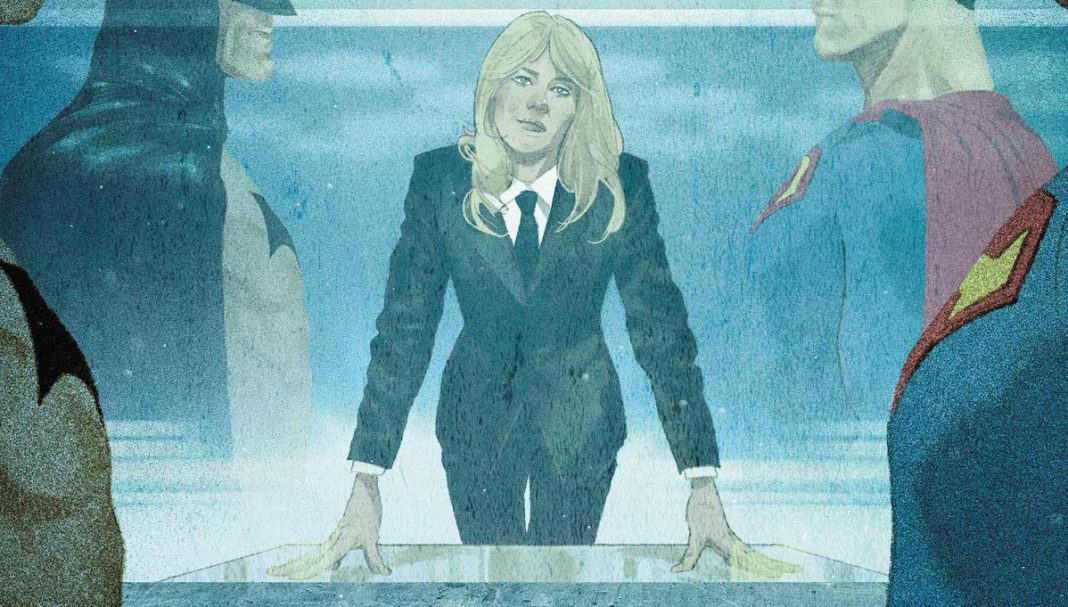
In the new Infinite Frontier era at DC Comics, Joshua Williamson is currently writing a six-issue miniseries entitled — that’s right — Infinite Frontier, which as the name implies is sort of a unifying narrative tying the rest of the shared superhero universe together.
Infinite Frontier is, essentially, the book that is directly picking up the most pieces after last year’s big event story, Dark Nights: Death Metal, which broke the multiverse down and left it more malleable, enabling creators to incorporate any and all of the past continuity they see fit. That’s the main conceit of Infinite Frontier. It’s a big event-style story, to be sure, but more than that it’s a book that reminds readers that every corner of DC Comics continuity is now fair game, doing so not just with the miniseries but with a series of tie-in vignette short comics that focus on more obscure characters.
Enough of my rambling about it, though! As noted in the intro to this post, I recently had the chance to talk with Williamson himself about writing this book, as well as the state of creator collaboration at DC and where this all might be heading. Check out our chat below!
ZACK QUAINTANCE: All of us here at The Beat’s DC Round-Up team have been really loving all of Infinite Frontier so far –the one-shot, the series, and the Secret Files stories. It checks so many different esoteric DC continuity interests. All of us have at least one specific thing we’ve latched on to and are paying attention to.
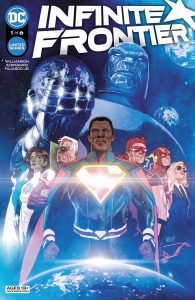
JOSHUA WILLIAMSON: So, I’ve been a DC fan for — I guess I could say for my whole life — and I have my own pockets of DC fandom that I’ve always gravitated toward. You can see that in the work I’ve done for DC over the last five years and the things I’ve gotten obsessed with, whether it was Flash or when I was working on Suicide Squad stuff. But here, I was able to touch on stuff that you don’t normally see right now, like Chase and Bones, and a little bit of Obsidian and Jade, Roy [Harper], and some other grounded pieces of the DCU that I’ve always liked seeing. I was able to go in and touch on stuff that isn’t really touched on.
QUAINTANCE: How challenging is that for you as a writer? It seems entirely wide open in terms of where you can take this story, which I imagine can make it both easier and more difficult for you creatively.
WILLIAMSON: This is Act I of a really big plan we have, so there are certain touch points I know we have to get to, and there are certain pieces of — not just my story, but other people’s stories — that I have to navigate, engineer or drive things in certain directions. At the same there is a lot of freedom. I got lucky with this one, because this is something I’ve been part of from Day One. I was in the initial calls pitching what Infinite Frontier was going to be post-Death Metal last year.
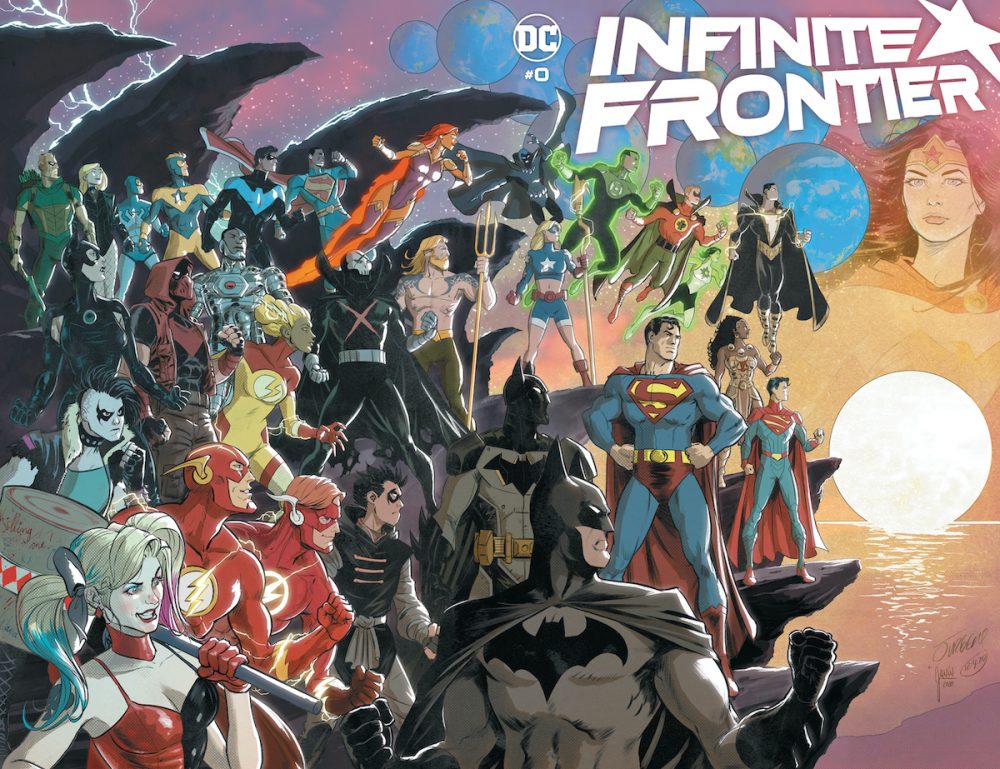
I was able to be there at the very beginning of these conversations and to see all the pieces come together. I got to pick and choose the stuff I was really interested in. I do have a lot of freedom, but at the same time I definitely have to navigate certain pieces of it to make sure things go where they need to go. I never want to mess with someone else’s story. Again, it’s part of this huge plan we have. I basically created five or six different stories for the Infinite Frontier book that will all come to a head. They’re all going to collide at some point.
QUAINTANCE: The scope of it feels even wider than that if you look at the Secret Files comics you’ve been co-writing as well. How does that series relate to the main book and what’s the relationship between the two of them?
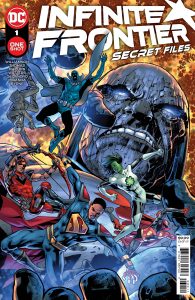
WILLIAMSON: With Secret Files, we were working on Infinite Frontier when we started developing the characters and talking about what characters we were going to use. Two things came up. One was, do people know who all these characters are, do they know what they’re about, where they’re from, and what their place is in the DCU? Then it was also about trying to bridge the gap from the zero issue to issue one, creating content that would bridge that gap because we knew it would be a three month gap. It was intended to be a three month gap to make it a surprise that it was be a series.
We started talking about that, and we asked, what if we did a digital-first series? What if we did six chapters and made them 12 pages each? As we talked about it, I was like, I do not have time for this, not really, not in the way I have time for other books, because I’m writing a lot for DC right now. So how about this, what if I co-write them? What if I pick the writers, people I know who also know the DCU really well and are just talented, new writers at DC. It was actually really easy.
In the past — working on Metal or Death Metal or the other events we’ve done at DC in the past five years — there’s been co-writing situations sprinkled through. Obviously, I’m really used to co-writing with Scott [Snyder] and James [Tynion IV], and I’ve done consulting on some of the events, particularly Metal and Death Metal. So here, I’ve known Brandon Thomas for a really long time. He used to write articles for Newsarama that were breaking in process articles. I met him through that, and I’ve gotten to watch him grow as a creator, and I’ve seen him do stuff for DC.
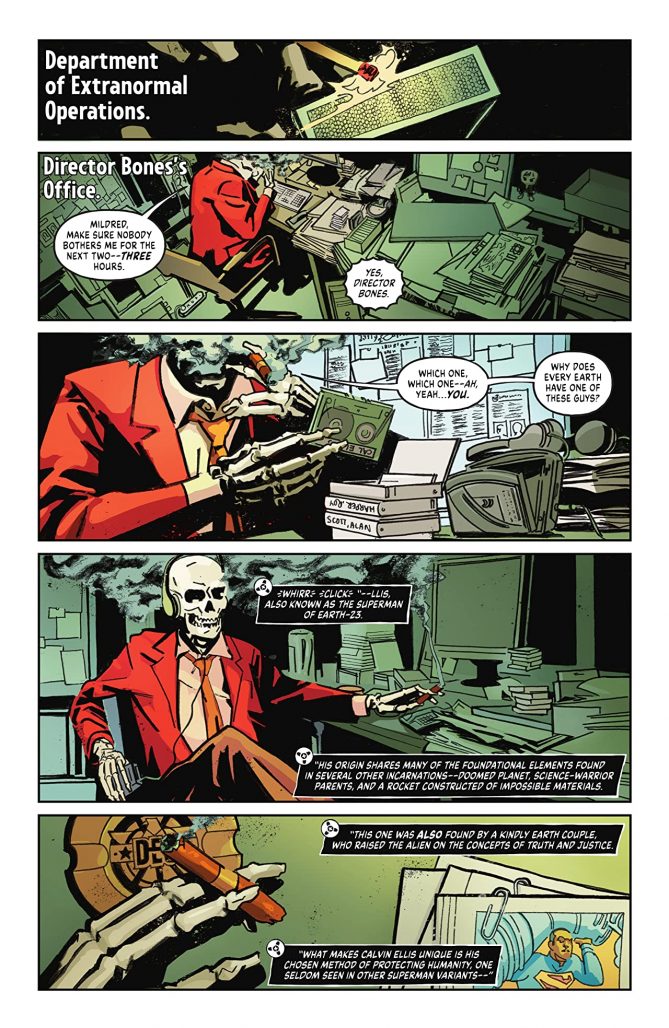
Brandon was the first person I brought in. Then Dan Watters. He’d worked on Lucifer and I really like Home Sick Pilots. I really like Dan, and with Dan in particular, I really like Dan’s writing and I wanted him specifically to write Psycho-Pirate. I felt he would really get that character, and he knows horror really well. All these people know the DCU really well, they know it’s history.
With Stephanie Phillips, I read Stephanie’s Harley Quinn, and we were in the Bat-group together. In the Bat-group we have these monthly calls where everyone talks about what they’re doing with their books, and we talk about story in general. We were talking about Harley and a few other books she’s working on, and it really made me be like, ‘this is someone who knows what’s up and I’d really like to work with them.’ Then I found out she’s a huge Green Arrow fan, so this was the person I wanted to write the Roy story then.
I emailed them all separately, like, this is what we’re doing and these are the six characters, let me know which of the six characters you want to work on. In my notes, I knew what I wanted them to write, but I still wanted them to pick. They all picked what I wanted them to pick! It was perfect. We got on a group call with everybody and we talked about what the goals were and how the characters were going to play into Infinite Frontier. It was incredibly easy. All three of them are really talented, then we started bringing in the artists. Once we started talking this stuff out, it was really easy. I would make notes on this stuff, but it was one of the easiest processes I had for something like this.
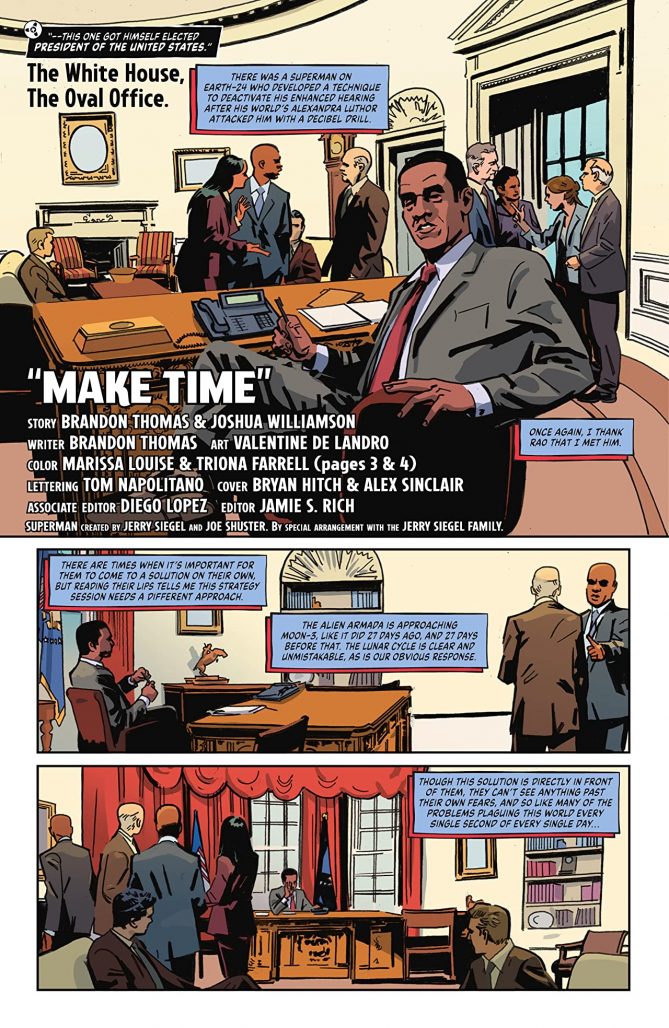
If you read Infinite Frontier, you’re going to get one story, but if you decide to read the Secret Files, you’re going to get a little bit more, you’re going to get behind-the-scenes stuff on what’s going on with those characters, a little more information about why they’re doing what they’re doing, particularly with Bones and Psycho-Pirate, as they are major catalysts in Infinite Frontier. I’m really happy with them, especially getting to work with these creators and tell these stories with characters you don’t normally get to see.
Getting to have a short about Jade and Obsidian, or a short about President Superman, it was nice getting a chance to do these character pieces. That was the thing I went to them with. I knew we had a driving force and we needed to get these characters to a certain place with Infinite Frontier, but at the end of the day, this was about who these characters are, what their motivations are. If you’ve never read these characters before, this will give you a glimpse of who they are.
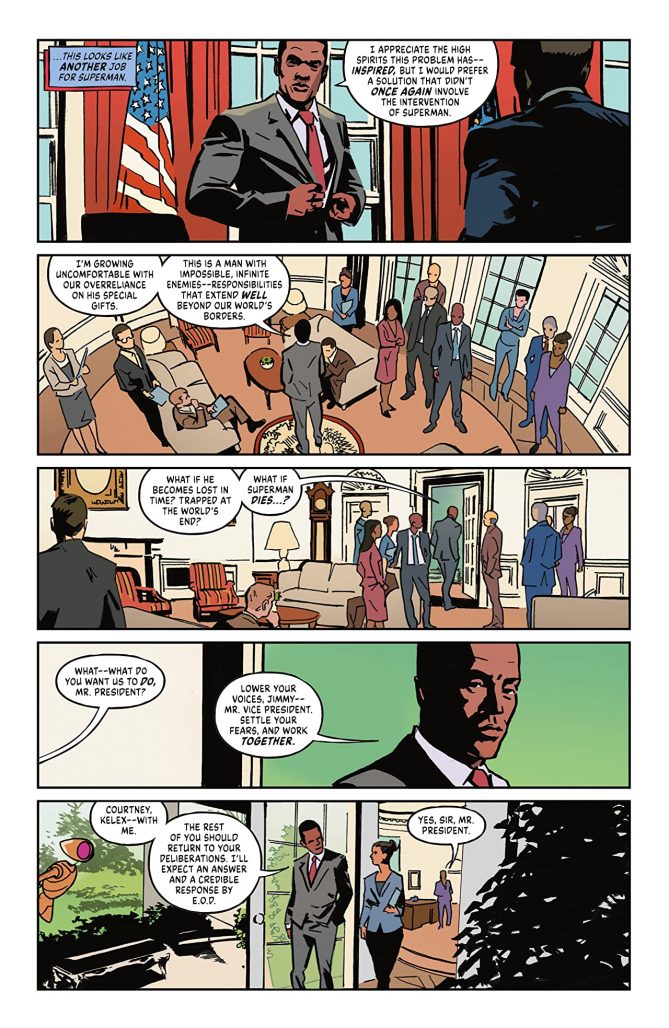
QUAINTANCE: I have a question from the rest of The Beat’s DC Round-Up crew, about Lian Harper specifically. There’s a Lian Harper running around in Catwoman, but it’s also been suggested that Lian Harper is dead. They want to know, will those threads align at some point?
WILLIAMSON: [pauses] They will align at some point.
QUAINTANCE: Alright…well, I’ve done my duty.
WILLIAMSON: [laughs] This is the thing! How to put this…there is a story to be told there, we just haven’t told it yet. I can’t go deep into it without ruining other people’s stories, and we were able to coordinate some of our plans for Roy and for that character. We’ll get there. You’ll see how it all adds up and how it really happened.
QUAINTANCE: I think you’ve touched on this here and there, but broadly speaking…what’s the collaborative relationship like linewide right now? It seems like what you’re doing with Infinite Frontier spans the entire DCU. So how are you working with other creators to align what you’re doing there with their plans for their books?
WILLIAMSON: It depends. I talk to James Tynion every day, probably too much. I have a foot in two groups: I have a foot in the bigger DCU stuff and because I write Robin, I have a foot in the Batman group. I’m in the meetings for both, and I talk to a lot of the writers probably too much. [laughs]
I just communicate with them as best I can. We have meetings every few weeks. It depends what the project is. I definitely lean on editorial a lot, and I don’t dictate to anybody what they’re doing. It’s more about finding out from editorial what everybody else is doing, and I pivot to line up with what they’re doing. I’ve said this before, but DC Comics is never one person. It’s all of us working together. It’s about working with editorial to find out what everyone is doing, and working from there.
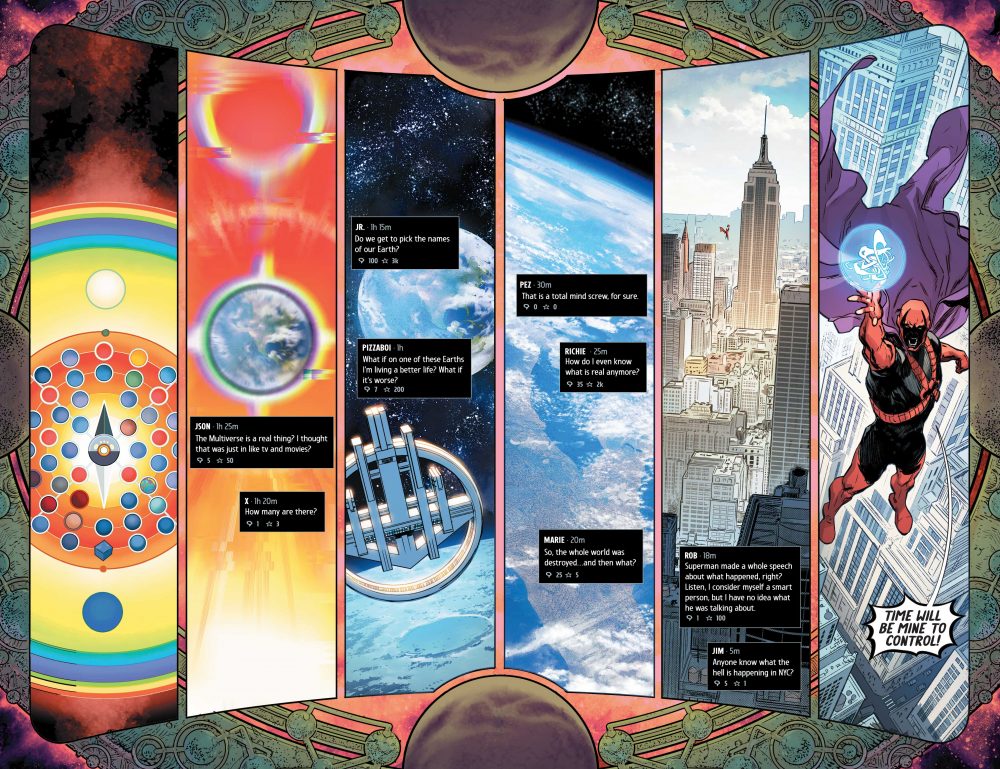
There are some creators I talk to more than others. We share things back and forth. With Tom Taylor, I’ll share stuff back and forth, and then he’ll share a script or a scene from the new Superman series with me. Some of that is because we’re just friendly with each other and want to share the cool stuff we’re working on. It’s really easy right now, because a lot of us know each other. In some cases we don’t. I have a call after this with a creator I’ve never spoken with before. We’re working on something later in the year, and it’s just a matter of getting on the phone and being like, here’s what I’m thinking, what are you thinking?
Right now with editorial with the different talents, there’s a lot more communication going on, definitely more than I’ve experienced. I think more people are talking to each other than ever before.
QUAINTANCE: I think that’s coming across in the comics, too. The two things this year that have gotten me so into what you all are doing is it seems like things are connected in ways they haven’t been, and it seems like these comics are really taking advantage of DC’s bench, showing how interesting some C and D list characters can be.
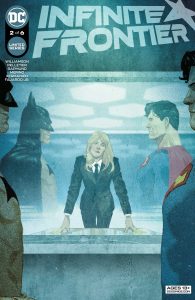
WILLIAMSON: This is a big part of my thoughts on DC in general over the next year and a half and the plans I have with Infinite Frontier…it is about showing the DCU from different points of view. Like this event right now — I’ve seen a big event like this from Superman, Batman, and Wonder Woman’s perspective. I’ve seen it from the Trinity’s perspective, I kind of want to see it from other perspectives, from people we don’t normally get to see. Something like Batman: Urban Legends gives us opportunities for back-up stories about other characters, just to see their stories. There are so many characters out there. It’s exciting right now to talk with other creators and have them say, I’m going to use this character I’ve wanted to touch on since I was a kid.
Like Ram V., Ram is a creator I love talking to about this stuff because he’s not as precious about it. I’ve been a DC fan my whole life, but Ram is not that kind of person, he wasn’t a huge fan going back 30 years like I am. So, he’s approaching these characters with a new, different point of view. Sometimes he’ll pitch me stuff for Justice League Dark — and I’ve told him this before — about using an obscure character, and to me it’s not an obscure character because I’m so embedded in it. But he’s right a lot of times. Nobody uses the character and it’s super-obscure. It’s great to see everyone trying these new things.
But we do talk a lot, and it’s a little different right now because we don’t have conventions. With Scott [Snyder], James [Tynion IV], and I, every New York Comic Con, we would go to Scott’s house for a couple days before the convention, figure a bunch of stuff out, and then go pitch it to people. That’s how a lot of Metal and Death Metal were planned out, Death Metal in particular. Superboy Prime’s involvement in Death Metal, we started talking about that at a convention in May or April of 2018.
I think next year, once conventions start, we may have more of that, but I think everyone is now so used to Zoom calls and doing it over the phone. I feel like it’s contributed to us talking more than we were before.
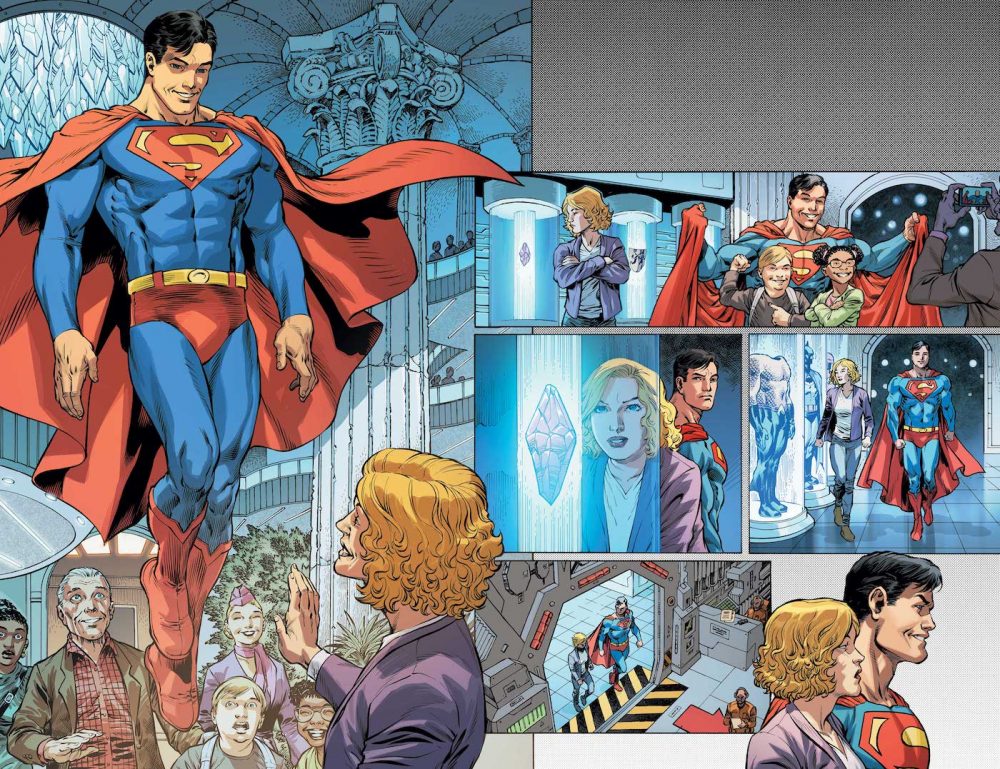
QUAINTANCE: And it seems like it would make it easier to loop in more people too, when you’re planning over Zoom calls.
WILLIAMSON: Yeah, and particularly with the Bat-group. The Bat-group under Ben Abernathy, he started setting up Zoom calls at the end of last year. Then James will do smaller Zoom calls. He and I don’t do that as much because I talk to James everyday, but it just depends what the books are, what their involvement is. There’s stuff we’re talking about that will be middle of next year, and I need to get on a call with some of those writers next month to just talk about what we’re doing and how we can make it work together.
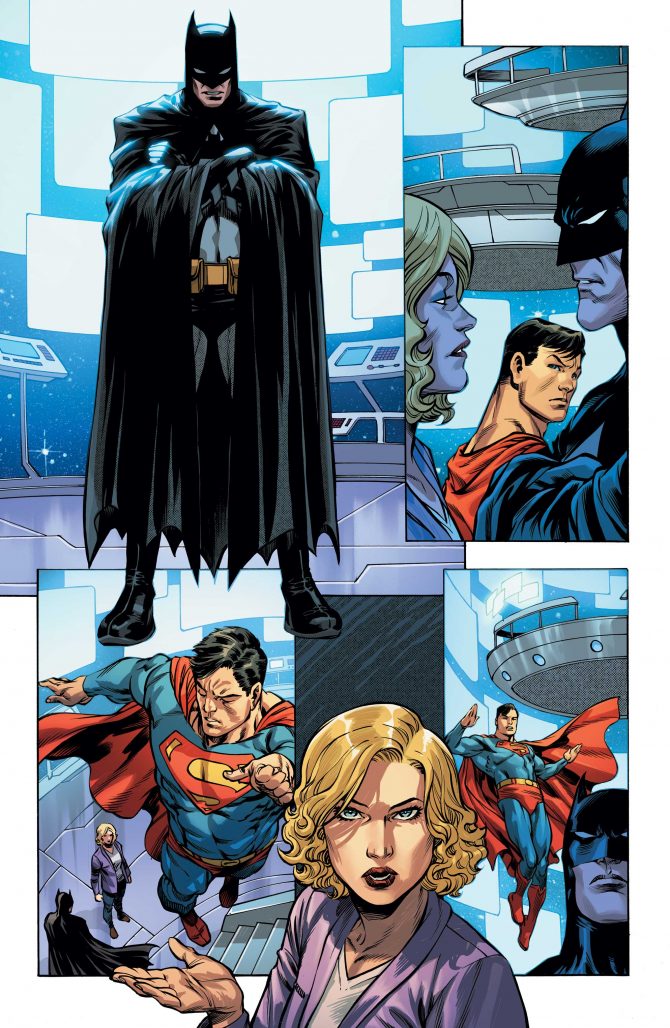
QUAINTANCE: Do you all have a set of really concrete continuity rules you’re working with right now? Reading these comics I can sense there’s parameters you’re using with continuity, but I have no idea what they might be.
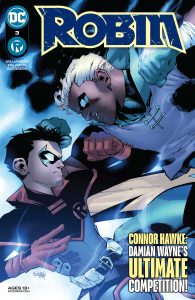
With Connor Hawke, I looked at what Connor Hawke’s history was. Connor Hawke was really easy, because Connor Hawke hadn’t appeared post-New 52. I just used their history from before. I didn’t make it up, I didn’t reinvent it. I remember we had this conversation at the beginning of Rebirth. In my very first official meeting about Flash in DC Rebirth, I pitched that I wanted to bring Max Mercury into the book really early. I wanted to bring him back immediately. My goal from the very beginning was to bring back all the Flash Family members.
At the time, I did not — because I was so new — even know what Rebirth was yet. My goal was to tell a cool Flash story. I didn’t know the big picture stuff. I was brought in two weeks later, but in my first meeting, I was like, I want to bring Bart back, I want to bring back XS, and I want to bring back Max Mercury. Max Mercury was the first one I was going for. I had a plan on how to bring Max into the story immediately. I was going to reinvent his origin. I had all these plans to modernize him, and I was told, no, his origin is his origin. He is who he is, so when you bring him back, you will bring him back as he was. We are not going to re-invent the wheel with him. That’s why when I brought him back toward the end, he was just Max. Same with Bart. I think that was part of New 52. They would bring these characters in, and they were re-invented, sometimes. It made it muddier in places.
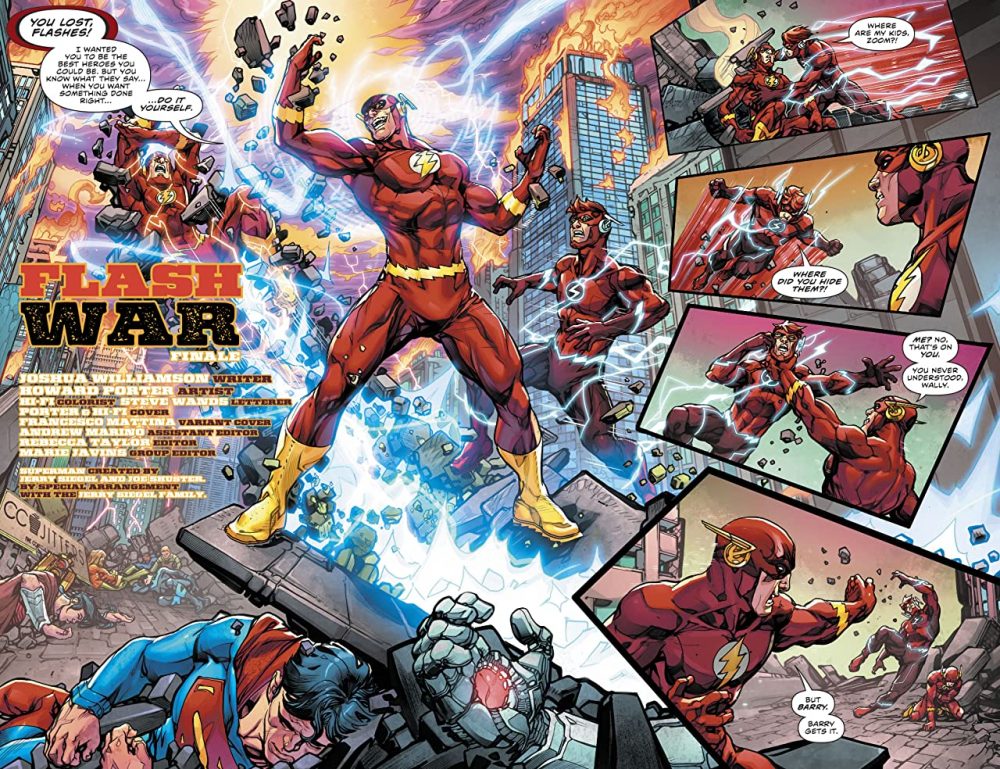
I look at it now as a mix of the two, and you cherry pick what’s best. We talk about it. We talk about what we’re going to do and how it can work, and you try to figure out the math for that character. Really, at the end of the day you’re just trying to tell the best story possible.
QUAINTANCE: Since you brought up Connor Hawke, I’m a HUGE Connor Hawke and Green Arrow fan. I wanted to ask if he’ll remain a prominent part of what you’re doing with Robin, or if you might end up doing more with Connor Hawke and Green Arrow in the future?
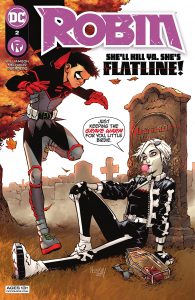
WILLIAMSON: Connor Hawke is a major part of the Robin book for the tournament arc, and the tournament arc is long. It’s not a short arc. The tournament itself doesn’t start until issue six. We were talking about one of the issues during the tournament, and I turned the script in. The editors were like, this is too packed. We all decided, let’s break it into two. I had to do some re-writing and some fixing, but for the most part, we didn’t want to rush it. Connor will be in the Robin book for a while.
We are talking about where Connor will go next, and I can’t really go too deep into that right now without spoiling some things. But there are plans for where Connor will go after Robin.
QUAINTANCE: I really like what you’re doing with the Robin book, too. It’s funny in a way I wouldn’t have expected.
WILLIAMSON: I just wanted to do something fun with the character, let it be paced a little differently and just try to have some fun with it. I’ve always liked Damian as a character, and I just feel like he fits this story so well. I’m glad people are responding to it, because it’s the most fun I’ve ever had at DC, working on that book, and it’s the easiest to write, too.
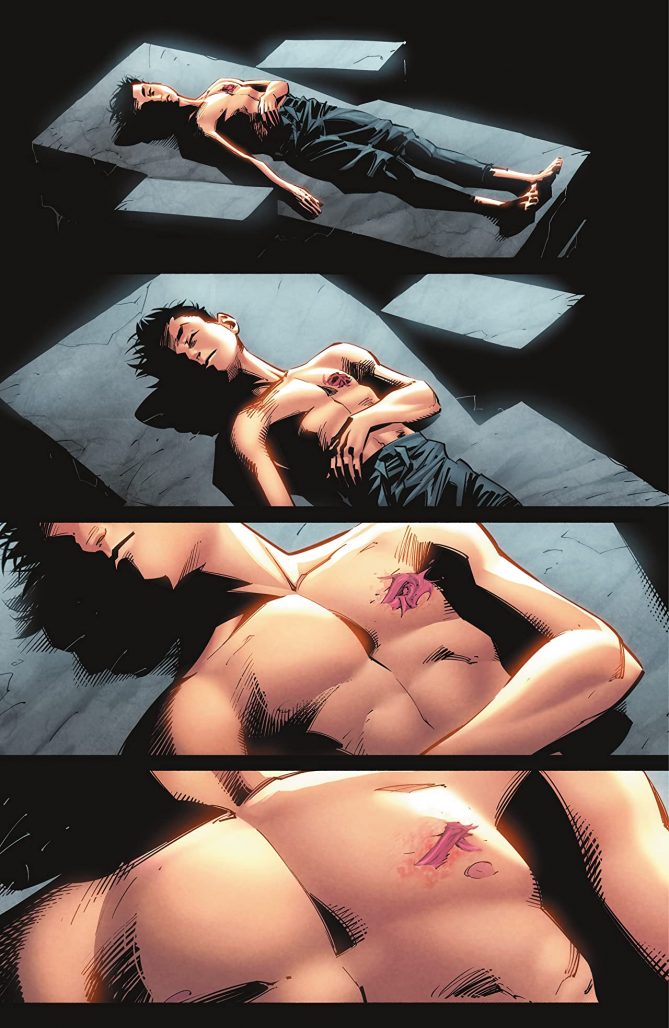
QUAINTANCE: It definitely shows. It seems like you and Gleb [Melnikov] are having a blast doing it.
WILLIAMSON: It’s so crazy. Gleb and I knew each other online for a couple of years. I liked his work, so we would talk, but once he started really working on it, it was so weird. It really did click, and it was like I’d known this person my whole life. We have so much in common, and our tastes are so aligned. Movies, comics, and our thoughts on things are very on the same page. It’s interesting working with him on this book. Every time I turn a script in and he and I talk things out, we’re both very much on the same page. We’re coming at it with the same references, so I can mention stuff in the script without going deep into it because he knows what I’m talking about. So, he’s able to run with it.
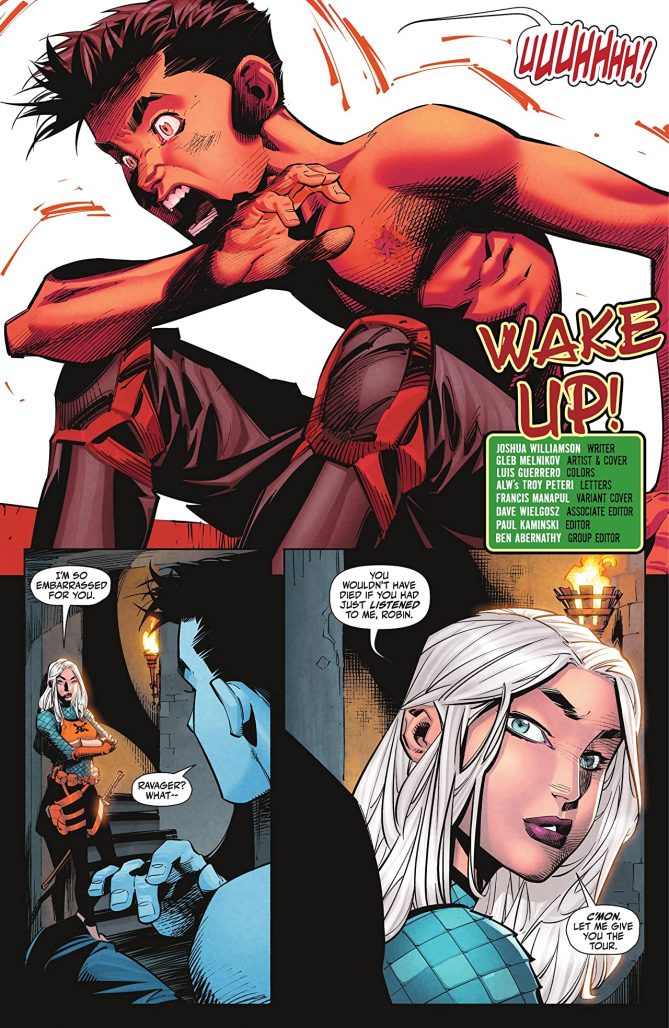
QUAINTANCE: Before we wrap up, is there anything you think is interesting about Infinite Frontier that I’m missing? Anything you want to let readers know about?
WILLIAMSON: I hope readers see that we’re doing something different. After the last couple years, all the events were definitely gigantic concerts. For us, we wanted to do something that felt more like a house show, a smaller show, but it’s definitely going to get bigger. There’s a page in issue six where I lost count of how many characters are in this gigantic fight scene. I felt bad. I wrote Xermanico — who’s the artist on Infinite Frontier — a long email apologizing because there is so much going on in issue six. But it really is Act I of a really big story we’re telling. It’s going to be fun, and I think you’ll get to see the DCU from different perspectives through the whole thing. That’s what’s really important to me. I think one of the biggest ways to do something different is to show the DCU from different perspectives.
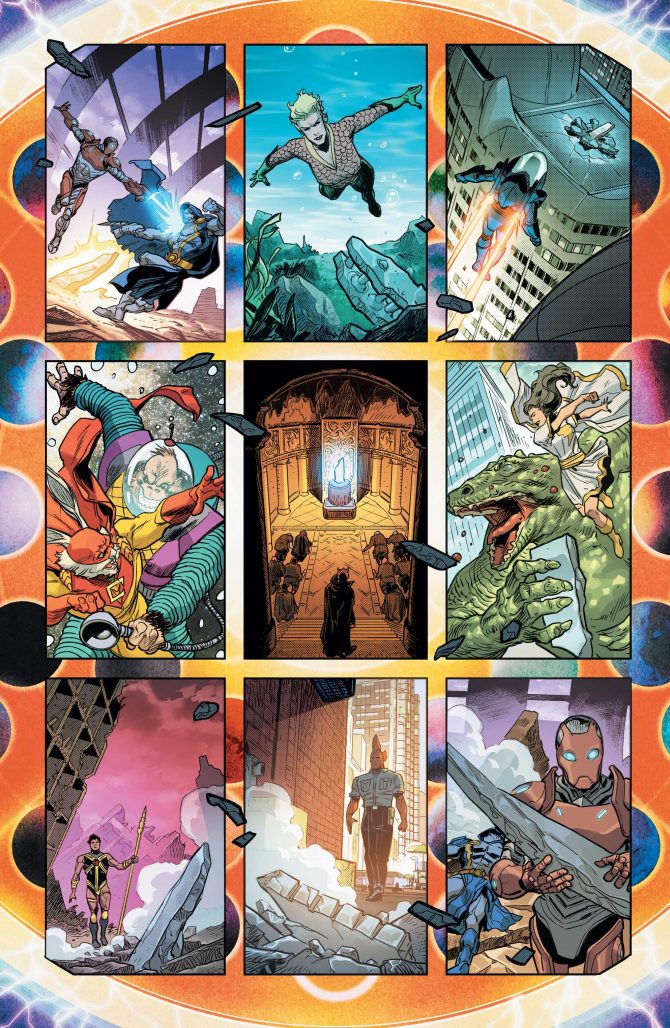
QUAINTANCE: Can you tip any characters we should be excited to see soon?
WILLIAMSON: That’s tough. There’s a lot that comes in the story. Every issue ends I think in a really cool way. Issue three has one of my favorite endings from the whole thing. All of them are cool, and I think there’s stuff coming that will surprise people throughout. There’s a lot of characters that show up at the end of three and at the end of issue four. There’s a lot of stuff coming I think people will be surprised by.
Want to check out The Beat’s weekly DC Comics reviews? Check out our full archive!


